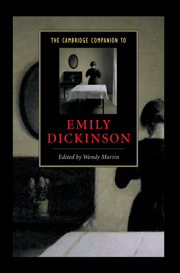Book contents
- Frontmatter
- Introduction
- Part 1 Biography and publication history
- Part 2 Poetic strategies and themes
- 4 Emily Dickinson and poetic strategy
- 5 Emily Dickinson’s existential dramas
- 6 Performances of gender in Dickinson’s poetry
- 7 Emily Dickinson
- 8 Emily Dickinson and the Gothic in Fascicle 16
- Part 3 Cultural contexts
- Select bibliography
- Index
6 - Performances of gender in Dickinson’s poetry
from Part 2 - Poetic strategies and themes
Published online by Cambridge University Press: 28 May 2006
- Frontmatter
- Introduction
- Part 1 Biography and publication history
- Part 2 Poetic strategies and themes
- 4 Emily Dickinson and poetic strategy
- 5 Emily Dickinson’s existential dramas
- 6 Performances of gender in Dickinson’s poetry
- 7 Emily Dickinson
- 8 Emily Dickinson and the Gothic in Fascicle 16
- Part 3 Cultural contexts
- Select bibliography
- Index
Summary
This essay discusses how poet and reader perform gender in Dickinson's poetry. Our discussion depends on a two-pronged general argument: first, that both gender and the lyric poem in and of themselves constitute performances and, second, that reading a lyric poem interpretively - that is, reading it seriously - also constitutes a performance. These general propositions, which borrow from performance and reader-response theories, support our more particular claims that Dickinson's poetry and the reading of gender in Dickinson's poetry constitute intersecting performances even beyond the level generic to lyric poetry. Specifically, Dickinson both constructs alternatives to a traditional, fixed binary gender system (woman/man) and opens opportunities for the reader to perform alternative genderings. Moreover, she implies that the woman poet herself cannot be conventionally gendered. Despite the fact that Dickinson's work is frequently literally performed and many critics have commented on the extent to which it demands active response from its readers, the ways in which textual performance underscores Dickinson's writing has not been examined. In this essay we outline the principles supporting our argument and then analyze performances of gender in and of Dickinson's poems to show that her variant performances of gender are crucial to the general construction of her poetry.
- Type
- Chapter
- Information
- The Cambridge Companion to Emily Dickinson , pp. 107 - 128Publisher: Cambridge University PressPrint publication year: 2002
- 2
- Cited by



